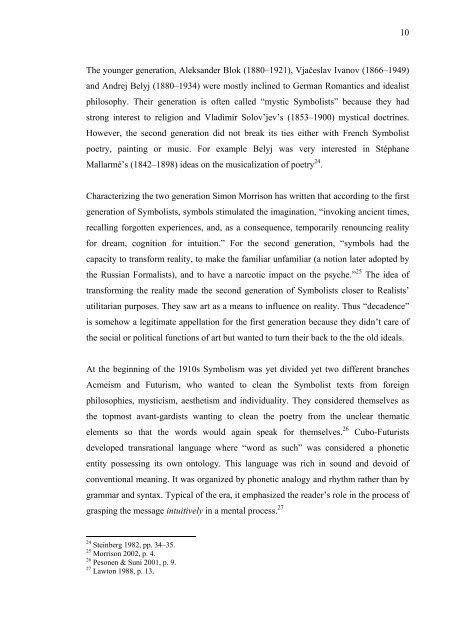Boris Asaf'ev and the Soviet Musicology - E-thesis
Boris Asaf'ev and the Soviet Musicology - E-thesis
Boris Asaf'ev and the Soviet Musicology - E-thesis
You also want an ePaper? Increase the reach of your titles
YUMPU automatically turns print PDFs into web optimized ePapers that Google loves.
The younger generation, Aleks<strong>and</strong>er Blok (1880–1921), Vjačeslav Ivanov (1866–1949)<br />
<strong>and</strong> Andrej Belyj (1880–1934) were mostly inclined to German Romantics <strong>and</strong> idealist<br />
philosophy. Their generation is often called “mystic Symbolists” because <strong>the</strong>y had<br />
strong interest to religion <strong>and</strong> Vladimir Solov’jev’s (1853–1900) mystical doctrines.<br />
However, <strong>the</strong> second generation did not break its ties ei<strong>the</strong>r with French Symbolist<br />
poetry, painting or music. For example Belyj was very interested in Stéphane<br />
Mallarmé’s (1842–1898) ideas on <strong>the</strong> musicalization of poetry 24 .<br />
Characterizing <strong>the</strong> two generation Simon Morrison has written that according to <strong>the</strong> first<br />
generation of Symbolists, symbols stimulated <strong>the</strong> imagination, “invoking ancient times,<br />
recalling forgotten experiences, <strong>and</strong>, as a consequence, temporarily renouncing reality<br />
for dream, cognition for intuition.” For <strong>the</strong> second generation, “symbols had <strong>the</strong><br />
capacity to transform reality, to make <strong>the</strong> familiar unfamiliar (a notion later adopted by<br />
<strong>the</strong> Russian Formalists), <strong>and</strong> to have a narcotic impact on <strong>the</strong> psyche.” 25 The idea of<br />
transforming <strong>the</strong> reality made <strong>the</strong> second generation of Symbolists closer to Realists’<br />
utilitarian purposes. They saw art as a means to influence on reality. Thus “decadence”<br />
is somehow a legitimate appellation for <strong>the</strong> first generation because <strong>the</strong>y didn’t care of<br />
<strong>the</strong> social or political functions of art but wanted to turn <strong>the</strong>ir back to <strong>the</strong> <strong>the</strong> old ideals.<br />
At <strong>the</strong> beginning of <strong>the</strong> 1910s Symbolism was yet divided yet two different branches<br />
Acmeism <strong>and</strong> Futurism, who wanted to clean <strong>the</strong> Symbolist texts from foreign<br />
philosophies, mysticism, aes<strong>the</strong>tism <strong>and</strong> individuality. They considered <strong>the</strong>mselves as<br />
<strong>the</strong> topmost avant-gardists wanting to clean <strong>the</strong> poetry from <strong>the</strong> unclear <strong>the</strong>matic<br />
elements so that <strong>the</strong> words would again speak for <strong>the</strong>mselves. 26 Cubo-Futurists<br />
developed transrational language where “word as such” was considered a phonetic<br />
entity possessing its own ontology. This language was rich in sound <strong>and</strong> devoid of<br />
conventional meaning. It was organized by phonetic analogy <strong>and</strong> rhythm ra<strong>the</strong>r than by<br />
grammar <strong>and</strong> syntax. Typical of <strong>the</strong> era, it emphasized <strong>the</strong> reader’s role in <strong>the</strong> process of<br />
grasping <strong>the</strong> message intuitively in a mental process. 27<br />
24 Steinberg 1982, pp. 34–35.<br />
25 Morrison 2002, p. 4.<br />
26 Pesonen & Suni 2001, p. 9.<br />
27 Lawton 1988, p. 13.<br />
10

















